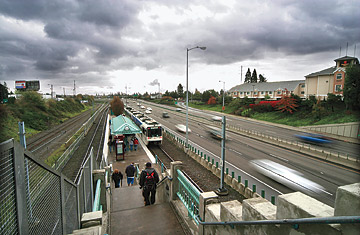
A light rail system runs along the interstate in Portland, Oregon.
Maybe the most unlikely thing that Barack Obama has accomplished in the past few months is that he's made infra-structure sexy. O.K., not sexy, but at least a hot topic. Rebuilding scuffed and threadbare roads and bridges all around the U.S. is an Obama priority. The recent stimulus package contained $8 billion to develop new intercity high-speed rail lines.
But the biggest single chunk of infra-structure in the U.S. is the interstate highway system, more than 47,000 miles (76,000 km) of multilane roadways connecting every major American city. And people who spend time envisioning improved systems for energy and transit have ideas for the interstates that go far beyond fresh asphalt and new guard-rails. They've been talking up ways in which the big roads could become the backbone of a larger network of railways and broadband cables and even a new, more efficient electrical power grid.
The construction of the interstate highway system, which Congress authorized in 1956, was one of the great can-do enterprises of the post-World War II era, the largest public-works project in history. But now the interstates look like a vast monument to the law of unintended consequences. They turned out to be the great enabler of America's car culture and the fossil-fuel consumption that goes with it. And by making it possible to live far from where you work, they were the key element in the phenomenon of suburban sprawl.
So can the big roads be remade into something better than 47,000 miles of temptation? This is where the new thinking about a highway/light-rail/power-grid nexus comes in. The first great advantage of the interstates is that they represent an established right of way. The government owns the road-beds and adjacent land, so rail and power lines can be laid down without the need to purchase more land. "Right of way is a precious resource," says Representative Earl Blumenauer, an Oregon Democrat who has become a point person in Congress on infrastructure issues. "It's been developed over centuries at great cost. It's strategically located and immediately available."
And it's already being put to use in some places. In the new expansion of the Portland Light Rail system in Oregon, the trains run alongside the road. And in Portland some stretches of that road are also being equipped with solar panels to power the roadside lights. But maybe the most audacious idea comes from the Al Gore-affiliated Repower America, a clean-energy advocacy group. Highways could be one of the routes for the new, more efficient electrical power grid that Repower advocates. And that grid would be available for battery-powered and hybrid vehicles to draw from and even sell surplus power back to. Envision a system in which you drive to a light-rail station along the interstate, plug into a smart grid at the parking lot and ride the train to work while your car recharges.
But making these ideas work will require an unusual degree of coordination among states, regions and regulatory bodies. "There's one group of people looking at highways," says Shelley Poticha, president of Reconnecting America, a mass-transit advocacy group. "There's another looking at passenger rail and a different group looking at freight." She thinks the solution is a bipartisan federal commission "like the commission that oversaw military-base closings, so that we can have a strategy for the highways." It was, after all, one great federal effort that built the interstates. Maybe it can be another one that rebuilds them.